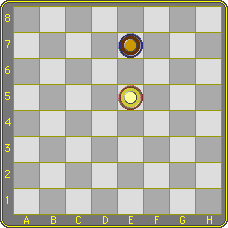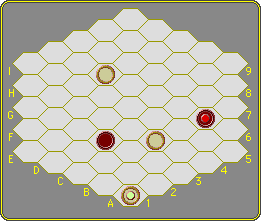Page 7 of 7
King versus kings
Checkers
The number of kings needed to capture a lone one is a rough but pretty reliable indicator of a game's margin of draws. Here are some key positions.
 |  |
In Checkers it's all about 'the move' and the tric-trac corner. 'Having the move' means being able to take opposition - in the left diagram, the player to move does not have the move!
On an odd-sided board without tric-trac corners, a king versus king position will always be a win for the player with the move. On 8x8 it can go either way: on the left black to move loses, white to move is a draw because white can retreat into the tric-trac corner.
To ensure a win you need two kings. On the right white to move loses: black invades the corner. If it's black to play he can reverse the move with g3f2 and f4e3.
Turkish
 | White can start from the position shown. Black cannot occupy the 6 center files, so he can only place his king in a1 (on h1 white moves a71). The sequence is:
|
Armenian and Dameo
 | Armenian and Dameo have an identical endgame, that differs from Turkish because of the games' diagonal movement. Yet the same premiss regarding the above position holds. Other than in Turkish however, the position below - black to move - is an immediate win. If it is white's move, he can reverse the tempo:
|
Hexdame
 |  |
In HexDame 3 kings will always capture a lone one in three moves or less. A key formation is given on the left. On the right white, to move, will obviously lose a man, yet he wins the game. Barring rotations and reflections,the problem gave rise to 16 unique (but quite regular) 2x1 positions, that are a win.
This shouldn't shroud the fact that generally speaking three kings are needed.
Draughts
 |  |
In Draughts, barring some 10.000 of over 2.500.000 three against one positions, one needs four kings to capture a lone king. With four kings the capture is so easy that it suggests overkill. On the left a position where three kings do the job, but it is the exception, not the rule. On the right one of many positions to indeed capture the reluctant sucker.
In comparison with the other games, the situation Draughts is embarrassing.
One way to remedy the problem is to make king's subject to the demotion rule as in 'KillerDraughts': if the king is obliged to stop on the square immediately behind the last piece captured, then two kings in a tric-trac corner are sufficient to capture a lone king!
However small this change may be, and however good, it will affect a large part of the existing theory and that may prove too much to swallow for the draughts community at large. Few may be waiting for a slightly different rerun of basically the same game, despite the smaller margin of draws it provides.
Conclusion
The games in the straight plane are the clear winners here. Draughts players, please hide your hidden agendas, open your minds and listen carefully: Draughts is the most drawish of the long-range games due to an intrinsic flaw.
It can't be remedied, it won't go away - you're playing the wrong game.
